 Somewhere, it seems like a group of light plane developers must have held a meeting and decided that low wing manufacturers needed to broaden their line to include high wings. A batch of new models has been unveiled or announced this year. (Article updated 2PM – 7/29 Fri — new image of the gorgeous taildragger; see below)
Did these builders not notice the industry already has a whole slew of popular high wing models? Some, like Flight Design’s CT series, has been a market leader since the beginning. Companies in the list below didn’t follow the leader then? Why now?
Of course, no such industry agreement happened. Each company examined their lines and chose individually to go forward with their designs. Honestly, they’ve all come out so recently they could not have coordinated such a broad launch in a single year even if they tried.
Nonetheless, here they are, one after another.
Somewhere, it seems like a group of light plane developers must have held a meeting and decided that low wing manufacturers needed to broaden their line to include high wings. A batch of new models has been unveiled or announced this year. (Article updated 2PM – 7/29 Fri — new image of the gorgeous taildragger; see below)
Did these builders not notice the industry already has a whole slew of popular high wing models? Some, like Flight Design’s CT series, has been a market leader since the beginning. Companies in the list below didn’t follow the leader then? Why now?
Of course, no such industry agreement happened. Each company examined their lines and chose individually to go forward with their designs. Honestly, they’ve all come out so recently they could not have coordinated such a broad launch in a single year even if they tried.
Nonetheless, here they are, one after another.Oshkosh 2022 – Day 4… TAF’s Sling HW with Rotax 915 is a Big, Comfortable Lightplane
Somewhere, it seems like a group of light plane developers must have held a meeting and decided that low wing manufacturers needed to broaden their line to include high wings. A batch of new models has been unveiled or announced this year. (Article updated 2PM – 7/29 Fri — new image of the gorgeous taildragger; see below)


Nonetheless, here they are, one after another. I like it. I’m a high wing guy. To each his own but my single greatest joy aloft is looking down, watching the landscape unfold ahead of me. High wings offer the best downward visibility.

Companies entering the high wing market in 2022, after previously producing only low wing models:
- BRM Aero — Bristell B8
- The Airplane Factory — Sling HW
- Van’s Aircraft — RV-15 (prototype flying)
- Sonex — Unknown? (still in early design)
The new high wing designs add to those from Flight Design, Tecnam, Pipistrel, Zenith, Rans, Kitfox, Just, Icon, Jabiru, Vashon, Aerotrek… plus many more. To see a whole list, go to PlaneFinder 2.0 and check the correct box.
Made for Mosaic?
These new low wing producers also seem to be preparing for the new Mosaic-induced market to come. Why do I write that? Because the first three in the list above are also rather large aircraft. Sling HW explicitly says that it is a four seater. The RV-15 from Van’s certainly looks similarly (it’s big), although because its a first prototype, the company could change the design as they progress. BRM Aero may be thinking similarly

As you can see, Sling HW is cantilevered, further enhancing that downward visibility while also making outback flying more predictable by not have wing struts to catch bushes or other obstacles. Yet the wing structure does not intrude into the cabin as the wing is mounted above the cockpit.

Not only is the high wing Sling on display in AirVenture Oshkosh, it flew all the way from South Africa to attend the show. Actually, two are on display at AirVenture and both flew across the Atlantic. While that sounds like and is quite an accomplishment, it is merely another day on the job for Sling pilots. On several occasions they have created a new design and promptly flew it around the globe. They’ve done such immensely long flights so often, it almost appears routine. It’s not. A load of preparation and aircraft modification go into such epic voyages (see nearby image with special antennas fitted; these are not intended for standard production aircraft).
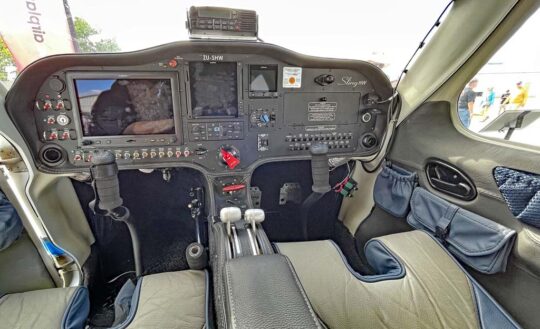
“The extra-large cabin features wide, easy-access doors, superb four-place ergonomics and best in class comfort and quality,” he contnued. “The removable rear seats increase the already generous baggage area providing for a great utility platform.”

The company explained, “For the first time we have a highly versatile aircraft that has a large useable cargo area. Remove the unused seats and controls quickly and easily, then fill it up with any kind of cargo. Sling High Wing can also be flown with the doors removed for photographic work or for use as a parachute jump ship.”
How Much?
As regular readers will probably recognize a large, four-seat, 912iS-powered aircraft will not be inexpensive. Sling HW sells for $93,306 with a airframe kits and will take 1,400 hours to complete. Buyers can pay $31,995 more for a Quick-Build kit that saves 500 hours of work.

To my eyes Sling HW is a comparison to deluxe American pick-up trucks that are loaded and have prices to match. Sling HW has such carrying capacity and modern equipment that it carries an appropriate sticker price. TAF noted, “[Sling HW’s] interior is leather upholstered with an option of full leather, the carpets are soundproofed and [the model has] a cabin heating and ventilation system. Seats are adjustable, as are the pedals [and] a luggage extension [is available] to accommodate longer cargo items such as skis, golf clubs, and surfing equipment.” Perhaps Sling HW is more a miniature version of Cessna Caravan than its Skyhawk.

The Airplane Factory
Sling HW High Wing
TECHNICAL SPECIFICATIONS
all figures provided by the manufacturer
- Wing Span — 31.3 feet
- Wing Loading — 14.8 pounds per square foot
- Fuel Capacity — 50 gallons
- Maximum Gross weight — 2,314 pounds
- Empty Weight — 1,279 pounds
- Useful Load — 1,035 pounds
- Payload with full fuel — 735 pounds
- Seating capacity — 4
- Cabin Width — 46 inches
- Baggage capacity — 77 pound
- Cruise Speed — 145 knots TAS (167 miles per hour)
- Maximum Climb Rate — 900 feet per mnute
- Stall Speed — 49 knots (56 miles per hour)
- Range at 75% power with 45-minute reserve — 880 nautical miles
- Endurance — 8 hours
- Takeoff Roll — 720 feet
- Landing Roll — 590 feet
LINKS:
- The Airplane Factory USA
- BRM Aero (article on B8 high wing)
- Bristell USA
- Van’s Aircraft (article to follow)
- Sonex Aircraft
- Rotax Aircraft Engines
COMING SOON!
More stories will follow AirVenture Oshkosh 2022. Today (Friday-July 29th) is my last day on site but more articles will follow a short break, including:
- More from FAA — including an announced date for the Mosaic NPRM
- Van’s RV-15
- Vee-Twin four stroke lightweight engine
- FAA’s annual safety briefing summary
- Icon’s latest A5 and their deluxe travel/storage trailer, and
- more news from AirVenture’s Fun Fly Zone, where the ultralights and more live.
Plus, I’ll be uploading several short videos. Give me a few days to decompress and I’ll be back on the job. Thanks everyone for reading this week’s articles. Your response has been record breaking and I sincerely appreciate it.
 Somewhere, it seems like a group of light plane developers must have held a meeting and decided that low wing manufacturers needed to broaden their line to include high wings. A batch of new models has been unveiled or announced this year. (Article updated 2PM – 7/29 Fri — new image of the gorgeous taildragger; see below)
Did these builders not notice the industry already has a whole slew of popular high wing models? Some, like Flight Design’s CT series, has been a market leader since the beginning. Companies in the list below didn’t follow the leader then? Why now?
Of course, no such industry agreement happened. Each company examined their lines and chose individually to go forward with their designs. Honestly, they’ve all come out so recently they could not have coordinated such a broad launch in a single year even if they tried.
Nonetheless, here they are, one after another.
Somewhere, it seems like a group of light plane developers must have held a meeting and decided that low wing manufacturers needed to broaden their line to include high wings. A batch of new models has been unveiled or announced this year. (Article updated 2PM – 7/29 Fri — new image of the gorgeous taildragger; see below)
Did these builders not notice the industry already has a whole slew of popular high wing models? Some, like Flight Design’s CT series, has been a market leader since the beginning. Companies in the list below didn’t follow the leader then? Why now?
Of course, no such industry agreement happened. Each company examined their lines and chose individually to go forward with their designs. Honestly, they’ve all come out so recently they could not have coordinated such a broad launch in a single year even if they tried.
Nonetheless, here they are, one after another.

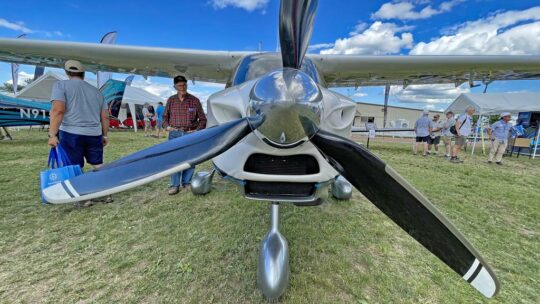
 Archon developers and sellers Dave Hertner and Bill Canino reported that younger pilots aren’t necessarily enamored of the WWII fighters. Those aircraft flew more than half a century before they were born.
Archon developers and sellers Dave Hertner and Bill Canino reported that younger pilots aren’t necessarily enamored of the WWII fighters. Those aircraft flew more than half a century before they were born. Designed by a Greek policeman working largely by himself on a modest budget, Archon is a clever bit of engineering. It is built surprisingly light and, as shown in the accompanying photos, weighs significantly less than most LSA types. The design has flown around 700 hours Dave and Bill told me, The aircraft in the nearby photos has 400 hours on it and — get this! — all of it wth about 40 horsepower.
Designed by a Greek policeman working largely by himself on a modest budget, Archon is a clever bit of engineering. It is built surprisingly light and, as shown in the accompanying photos, weighs significantly less than most LSA types. The design has flown around 700 hours Dave and Bill told me, The aircraft in the nearby photos has 400 hours on it and — get this! — all of it wth about 40 horsepower. Archon can be fitted with Rotax 912 or 915; the airframe is robust enough for 80 to 141 horsepower. “With our SF-1 Archon kit you can build your own modern fighter aircraft,” said Dave and Bill. They added that the original Lockheed model was designed “to project air dominance,” according to the U.S. Air Force. Fittingly, Archon is the ancient Greek word for “ruler.”
Archon can be fitted with Rotax 912 or 915; the airframe is robust enough for 80 to 141 horsepower. “With our SF-1 Archon kit you can build your own modern fighter aircraft,” said Dave and Bill. They added that the original Lockheed model was designed “to project air dominance,” according to the U.S. Air Force. Fittingly, Archon is the ancient Greek word for “ruler.” “The rapid build kits manufactured for SportairUSA may be reserved today, for delivery mid-2023,” said SportairUSA.
“The rapid build kits manufactured for SportairUSA may be reserved today, for delivery mid-2023,” said SportairUSA. “All kits are produced for SportairUSA by Fisher Flying Products, a Canadian company with decades of experience in kit aircraft manufacturing,” announced the partnership. “The majority of components are preformed aluminum. The kit includes all necessary hardware and material to build an SF-1 Archon, except the engine, avionics and paint.”
“All kits are produced for SportairUSA by Fisher Flying Products, a Canadian company with decades of experience in kit aircraft manufacturing,” announced the partnership. “The majority of components are preformed aluminum. The kit includes all necessary hardware and material to build an SF-1 Archon, except the engine, avionics and paint.” More Good FAA News
More Good FAA News
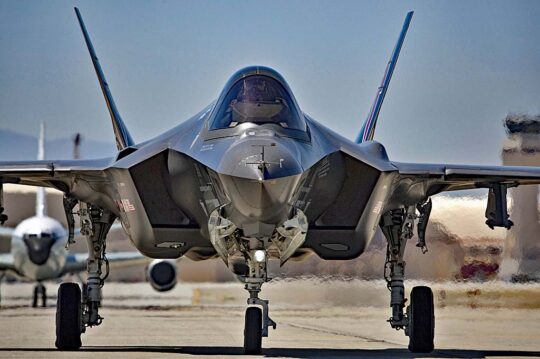

 Composite FX and their $60,000 ready-to-fly XEL model (kit for $47,000) completely changes that thought experiment. Not only does this handsome aircraft perform impressively in experienced hands but many can afford it.
Composite FX and their $60,000 ready-to-fly XEL model (kit for $47,000) completely changes that thought experiment. Not only does this handsome aircraft perform impressively in experienced hands but many can afford it.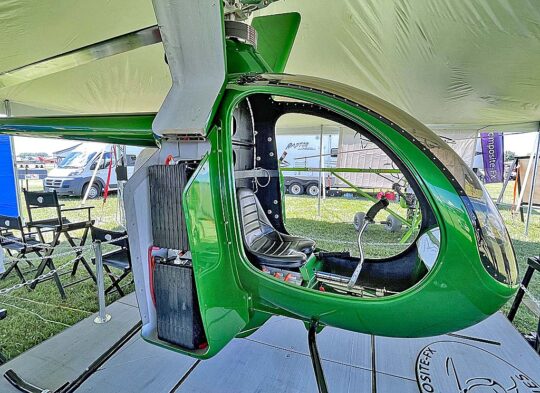 The mainstream media seems mesmerized with electric vertical takeoff and landing vehicles (eVTOLs) and the promise of “air taxis.” Development projects have attracted hundreds of millions of investment dollars …more than the entire LSA industry has spent to develop 157 models over 18 years.
The mainstream media seems mesmerized with electric vertical takeoff and landing vehicles (eVTOLs) and the promise of “air taxis.” Development projects have attracted hundreds of millions of investment dollars …more than the entire LSA industry has spent to develop 157 models over 18 years. This is not to doubt the technology these engineers are creating — from multicopters, to tilt wings, to ducted fans, to hybrid versions of all these. The truly intractable problems may be general public acceptance and regulatory accommodation.
This is not to doubt the technology these engineers are creating — from multicopters, to tilt wings, to ducted fans, to hybrid versions of all these. The truly intractable problems may be general public acceptance and regulatory accommodation. The project is too new to even have a name yet so I’ll label it “eXE” for now. The electric XE model has batteries contained in two side compartments (seen hinged up for viewing in nearby photos). Another battery is positioned below the electric power components.
The project is too new to even have a name yet so I’ll label it “eXE” for now. The electric XE model has batteries contained in two side compartments (seen hinged up for viewing in nearby photos). Another battery is positioned below the electric power components.


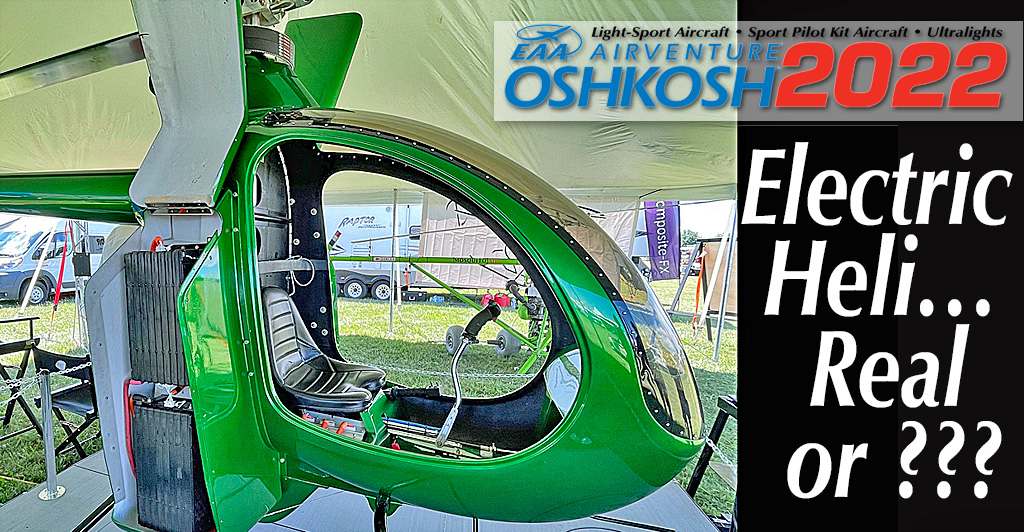


 As regular readers (or YouTube viewers) know, Mosaic is not being created solely for Light-Sport Aircraft. The coming rule encompasses warbirds, homebuilts, LSA, and Unmanned Air Systems (UAS). The latter includes all manner of electric and/or hybrid aircraft. Incorporating these very diverse segments under one regulation was a big undertaking. Evidently it proved too big.
As regular readers (or YouTube viewers) know, Mosaic is not being created solely for Light-Sport Aircraft. The coming rule encompasses warbirds, homebuilts, LSA, and Unmanned Air Systems (UAS). The latter includes all manner of electric and/or hybrid aircraft. Incorporating these very diverse segments under one regulation was a big undertaking. Evidently it proved too big. A couple months ago a big split was decided. The task of drafting regulations for such different aircraft is a large project, affecting many other regulations and touching different pilot communities.
A couple months ago a big split was decided. The task of drafting regulations for such different aircraft is a large project, affecting many other regulations and touching different pilot communities. The Bad News
The Bad News
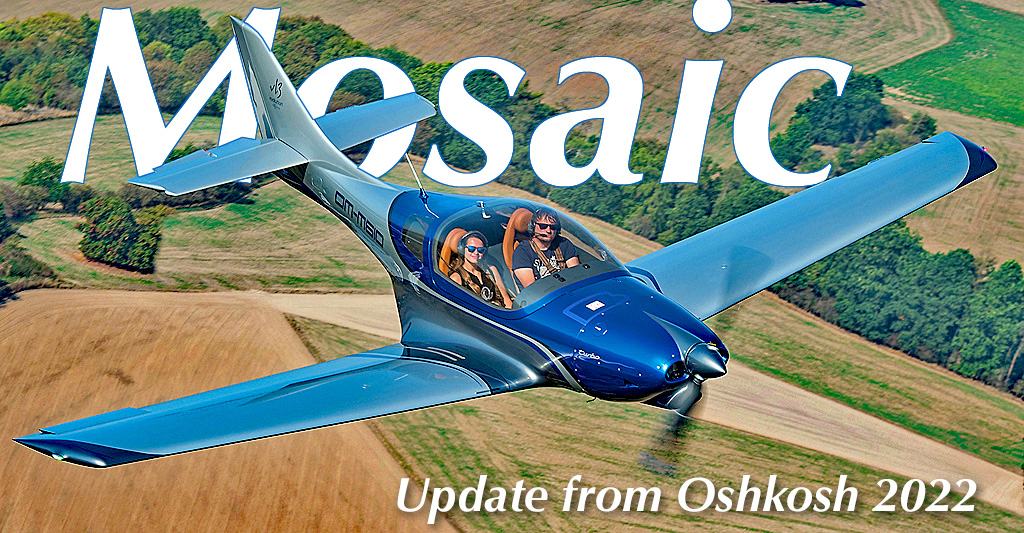
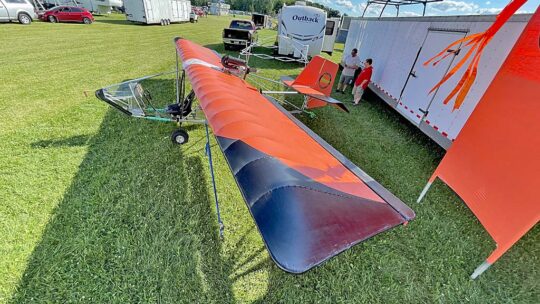 Matt’s background in aviation includes stints at airline and GA maintenance organizations. Doing similar work back in Wisconsin where he grew up, he found a number of T-Bird owners in need of parts they could not obtain. Calls to Indy Aircraft simply didn’t result in a supply of parts to keep those owners airborne.
Matt’s background in aviation includes stints at airline and GA maintenance organizations. Doing similar work back in Wisconsin where he grew up, he found a number of T-Bird owners in need of parts they could not obtain. Calls to Indy Aircraft simply didn’t result in a supply of parts to keep those owners airborne. A persistent man, Matt finally corralled Bret and after six months of negotiation, he acquired all intellectual property, design rights, and a stock of inventory. The large trailer seen behind this first Wisconsin T-Bird made eight fully-loaded trips back and forth from Iowa to bring all the materials to Berlin, Wisconsin, about 20 miles west of Oshkosh.
A persistent man, Matt finally corralled Bret and after six months of negotiation, he acquired all intellectual property, design rights, and a stock of inventory. The large trailer seen behind this first Wisconsin T-Bird made eight fully-loaded trips back and forth from Iowa to bring all the materials to Berlin, Wisconsin, about 20 miles west of Oshkosh. Work remains to make the design a bit leaner and lighter plus Matt needs to update assembly drawings he showed me. The instruction set looked reasonably good but some parts have changed and some drawings need to be redone.
Work remains to make the design a bit leaner and lighter plus Matt needs to update assembly drawings he showed me. The instruction set looked reasonably good but some parts have changed and some drawings need to be redone. Here’s a
Here’s a  A T-Bird TU — for “True Ultralight” — will follow. Matt is at work on this now. Using a paramoter engine as other Part 103 producers have embraced can contain empty weight to 227 pounds giving a generous remainder for essentials an owner may want.
A T-Bird TU — for “True Ultralight” — will follow. Matt is at work on this now. Using a paramoter engine as other Part 103 producers have embraced can contain empty weight to 227 pounds giving a generous remainder for essentials an owner may want.


 I am onsite starting Sunday the 24th looking for stories and aircraft of the type commonly reported here: Light-Sport Aircraft, kit aircraft Sport Pilots can fly, and ultralights. I will do my best to report daily…
I am onsite starting Sunday the 24th looking for stories and aircraft of the type commonly reported here: Light-Sport Aircraft, kit aircraft Sport Pilots can fly, and ultralights. I will do my best to report daily… Chris noted, “With AirVenture upon us, I want to remind pilots not to overlook Midwest LSA Expo occurring September 8-9-10, 2022 — just a little over one month after AirVenture.”
Chris noted, “With AirVenture upon us, I want to remind pilots not to overlook Midwest LSA Expo occurring September 8-9-10, 2022 — just a little over one month after AirVenture.” “Aero Affinity Holding Corporation has partnered with the City of DeLand to reimagine a major shift and exciting changes for the DeLand Sport Aviation Showcase,” announced the new collaboration (
“Aero Affinity Holding Corporation has partnered with the City of DeLand to reimagine a major shift and exciting changes for the DeLand Sport Aviation Showcase,” announced the new collaboration (



 Biplanes convey a vintage look but they also make for good hangar mates since their wingspan is usually shorter. Dingo is surprisingly compact with wings not even 22 feet wide.
Biplanes convey a vintage look but they also make for good hangar mates since their wingspan is usually shorter. Dingo is surprisingly compact with wings not even 22 feet wide. Comments from an early pilot outside the company included, “The first day was very windy [yet Dingo] handled it really well.” The next morning, calmer conditions allowed low passes and further exploring of flight qualities prompting an enthusiastic assessment, “Dingo is a real joy to fly and very well built.”
Comments from an early pilot outside the company included, “The first day was very windy [yet Dingo] handled it really well.” The next morning, calmer conditions allowed low passes and further exploring of flight qualities prompting an enthusiastic assessment, “Dingo is a real joy to fly and very well built.” Along with engineering partners Tomas Trojanek and Jan Jilek, the design was initiated by Marek in early 2021. After the first 3D images were shown to the Future Vehicles team, they decided, “Something like this has a place in the sky!”
Along with engineering partners Tomas Trojanek and Jan Jilek, the design was initiated by Marek in early 2021. After the first 3D images were shown to the Future Vehicles team, they decided, “Something like this has a place in the sky!” The control system features beautifully machined components (nearby images) connected to a control stick and rudder pedals with a unique foot stirrup up front. Full-span sheet-aluminium ailerons are mounted on the lower wings and a full flying stabilator is mounted on top of a T-tail. Dingo is flown with a right-hand joystick and left-hand throttle, similar to many tail draggers.
The control system features beautifully machined components (nearby images) connected to a control stick and rudder pedals with a unique foot stirrup up front. Full-span sheet-aluminium ailerons are mounted on the lower wings and a full flying stabilator is mounted on top of a T-tail. Dingo is flown with a right-hand joystick and left-hand throttle, similar to many tail draggers. A rotationally molded fuel tank is cleverly located inside the mast-like structure that is the pylon for both the engine and upper wing, providing a bracing point for the upper wing wires and the upper seat mount. A series of cut outs in the pylon shows the fuel level.
A rotationally molded fuel tank is cleverly located inside the mast-like structure that is the pylon for both the engine and upper wing, providing a bracing point for the upper wing wires and the upper seat mount. A series of cut outs in the pylon shows the fuel level.
 Lately, more designers of Part 103 ultralights have realized that these low weight, reasonably-high-power engines made worthy choices for the lightest of fixed wing aircraft. Such engines were key to the development of Dingo.
Lately, more designers of Part 103 ultralights have realized that these low weight, reasonably-high-power engines made worthy choices for the lightest of fixed wing aircraft. Such engines were key to the development of Dingo. The company may offer an airframe kit for around $15,000 (an estimate; please
The company may offer an airframe kit for around $15,000 (an estimate; please 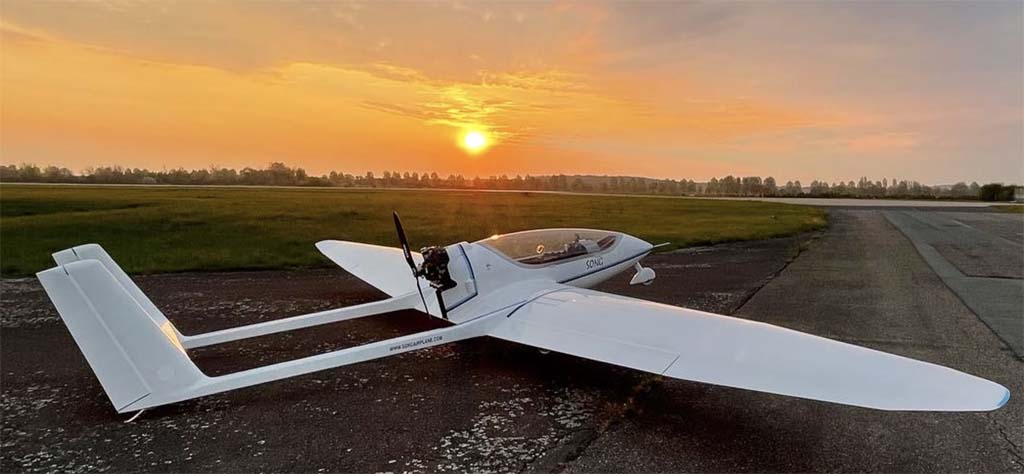
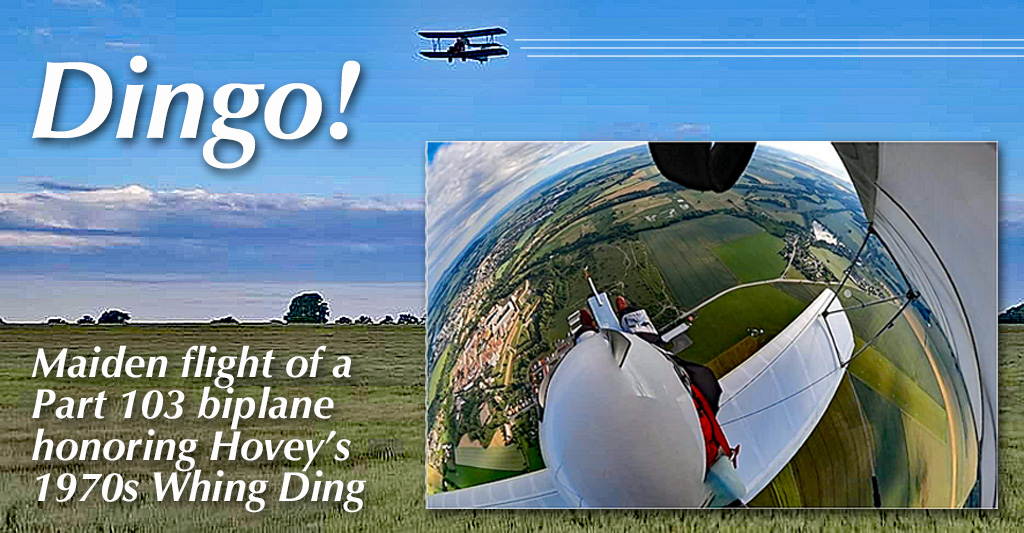
 One man created his own special way to log some flight hours getting to Oshkosh. Evidently this adventurous pilot never heard another popular line: “The shortest distance between two points is a straight line.” (Don’t anyone challenge me with Great Circle routes; this is about a long flight but not a globe-spanning one.)
One man created his own special way to log some flight hours getting to Oshkosh. Evidently this adventurous pilot never heard another popular line: “The shortest distance between two points is a straight line.” (Don’t anyone challenge me with Great Circle routes; this is about a long flight but not a globe-spanning one.) That’s still not enough for our Zenith aviator — but arriving KOSH will definitely be the icing on his cake, so to say.
That’s still not enough for our Zenith aviator — but arriving KOSH will definitely be the icing on his cake, so to say. “I wish I could have tried this before everything got so expensive, but the stars didn’t align,” explained Dave. He’s underway now, though. “This will be an all or nothing attempt: Oshkosh or Bust!“
“I wish I could have tried this before everything got so expensive, but the stars didn’t align,” explained Dave. He’s underway now, though. “This will be an all or nothing attempt: Oshkosh or Bust!“ “I would definitely appreciate any hospitality, accommodations and/or fuel along the journey. My final stop each day will be determined by weather mostly, so planning for the trip is going to be day by day.”
“I would definitely appreciate any hospitality, accommodations and/or fuel along the journey. My final stop each day will be determined by weather mostly, so planning for the trip is going to be day by day.” Dave said his Cruzer is “very inexpensive to fly and very quick to build. It’s a great combination.”
Dave said his Cruzer is “very inexpensive to fly and very quick to build. It’s a great combination.”

 “In 1928,” said the company, “what was to become the most successful Junkers sports aircraft left our Dessau production plant for the first time: a single-engine, two-seat, low-wing aircraft with an oval fuselage cross-section and corrugated sheet metal skin. The prototype was equipped with an 80 horsepower Armstrong-Siddeley engine.
“In 1928,” said the company, “what was to become the most successful Junkers sports aircraft left our Dessau production plant for the first time: a single-engine, two-seat, low-wing aircraft with an oval fuselage cross-section and corrugated sheet metal skin. The prototype was equipped with an 80 horsepower Armstrong-Siddeley engine.
 “In that year, 69 aircraft were manufactured, [some of] which set a number of FAI world records. Various European record flights were also carried out with the A50. Famously Marga von Etzdorf was the first woman to fly from Berlin to Tokyo in 1930 with her Junior A50.
“In that year, 69 aircraft were manufactured, [some of] which set a number of FAI world records. Various European record flights were also carried out with the A50. Famously Marga von Etzdorf was the first woman to fly from Berlin to Tokyo in 1930 with her Junior A50.
 From an engineer’s view, Kaelin has long experience in aircraft maintenance and put a large, qualified staff on the task (see video). The vintage-appearing construction looks rather labor intensive, as with most specialty manufacturing. With that in mind, their introductory price may be quite a value.
From an engineer’s view, Kaelin has long experience in aircraft maintenance and put a large, qualified staff on the task (see video). The vintage-appearing construction looks rather labor intensive, as with most specialty manufacturing. With that in mind, their introductory price may be quite a value. England’s
England’s  Swiss engineering and quality combined with a fascinating Art Deco look conveyed by the corrugated-skin airframe and its two, separated tandem seats will generate admiring looks at any airfield you visit.
Swiss engineering and quality combined with a fascinating Art Deco look conveyed by the corrugated-skin airframe and its two, separated tandem seats will generate admiring looks at any airfield you visit.

 Orlican can’t claim such high ground but through two years of Covid dislocations, the Czech Republic developer finished their second-generation LSA and the first one in the U.S. was delivered to its first customer, a flight school.
Orlican can’t claim such high ground but through two years of Covid dislocations, the Czech Republic developer finished their second-generation LSA and the first one in the U.S. was delivered to its first customer, a flight school. Look at the design. What popular model of aircraft does it resemble? If you guessed Cessna 182 Skylane, you are remarkably observant. Indeed, this model was created as an 80% scale imitation of Cessna’s popular four seater, just with two seats and built of composite rather than metal.
Look at the design. What popular model of aircraft does it resemble? If you guessed Cessna 182 Skylane, you are remarkably observant. Indeed, this model was created as an 80% scale imitation of Cessna’s popular four seater, just with two seats and built of composite rather than metal. Then, pricing… A new Cessna 182 is base priced beyond $500,000. Deon will sell his L600 Eagle for $150,000
Then, pricing… A new Cessna 182 is base priced beyond $500,000. Deon will sell his L600 Eagle for $150,000 Nearly 100 years ago, the original Orlican company was founded by engineers Beneš and Mráz in 1935. The factory was later nationalized by the government but in the 1990s, a new company — Schempp-Hirth Ltd., a brand well-known and widely respected in Europe for its sleek sailplane gliders — took over the air division of Orlican. Manufacturing of composite Scheme-Hirth gliders is current today.
Nearly 100 years ago, the original Orlican company was founded by engineers Beneš and Mráz in 1935. The factory was later nationalized by the government but in the 1990s, a new company — Schempp-Hirth Ltd., a brand well-known and widely respected in Europe for its sleek sailplane gliders — took over the air division of Orlican. Manufacturing of composite Scheme-Hirth gliders is current today. The first Orlican in America (seen in nearby photos with N-numbers) is already in use at
The first Orlican in America (seen in nearby photos with N-numbers) is already in use at 
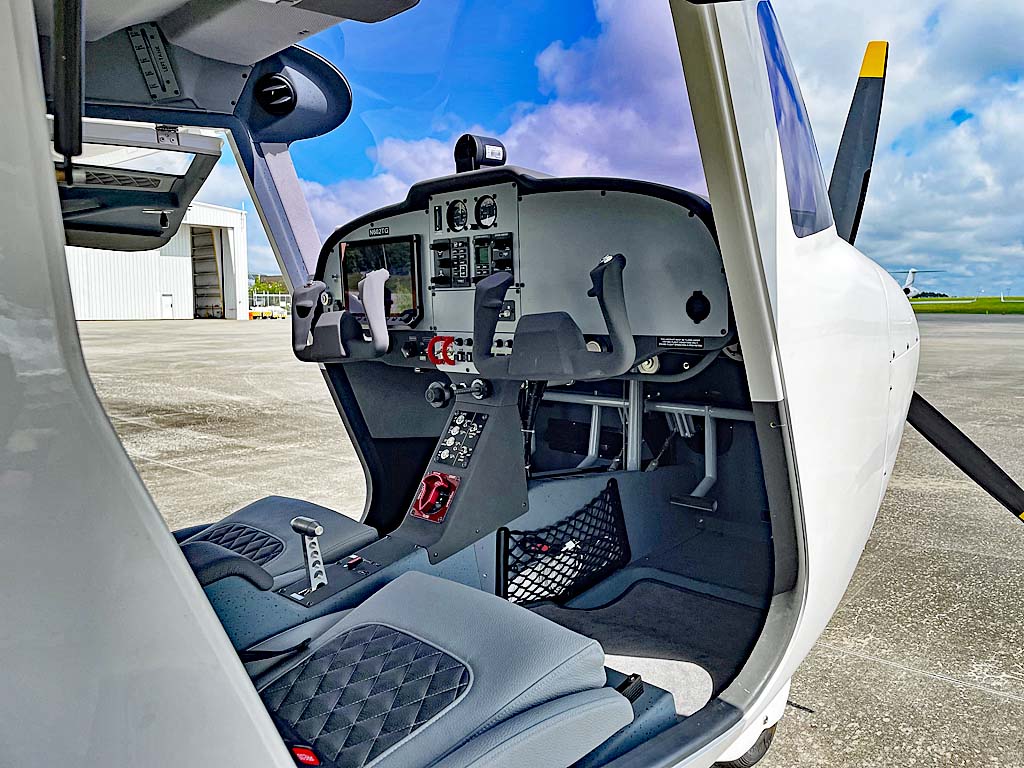


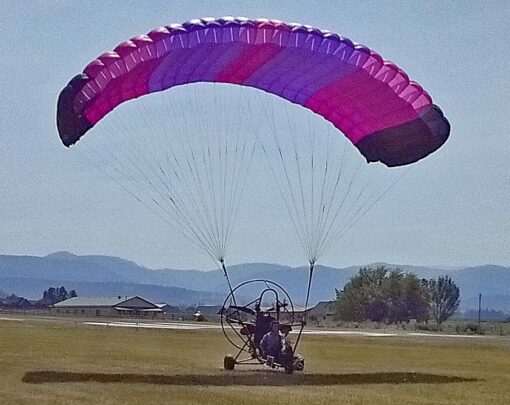 Six Chuter’s aircraft are enjoyable enough and the company careful enough about how it treated its prospects and customers that they managed to sell more than 2,100 aircraft since forming three decades back. Over many years of examining hundreds of companies, I am aware only a very small number of airplane producers that have built more than 2,000 aircraft. Six Chuter is clearly a company prepared to stick around for a while. Here’s a very brief look back at its history.
Six Chuter’s aircraft are enjoyable enough and the company careful enough about how it treated its prospects and customers that they managed to sell more than 2,100 aircraft since forming three decades back. Over many years of examining hundreds of companies, I am aware only a very small number of airplane producers that have built more than 2,000 aircraft. Six Chuter is clearly a company prepared to stick around for a while. Here’s a very brief look back at its history. Caleb reports he comes from a farming background, and for several years, enjoyed doing a lot of metal fabrication. Caleb brings a wealth of technical knowledge and skills that prepared him for his next endeavor.
Caleb reports he comes from a farming background, and for several years, enjoyed doing a lot of metal fabrication. Caleb brings a wealth of technical knowledge and skills that prepared him for his next endeavor.
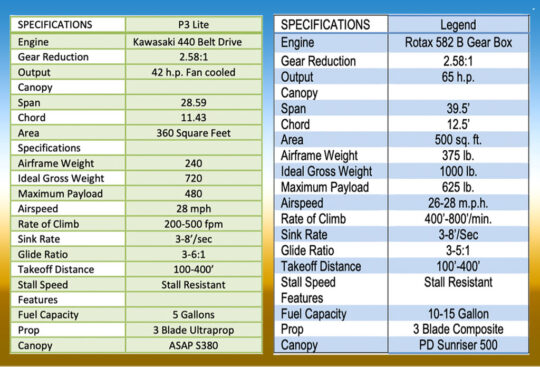 “Add fully functional dual controls to any of our tandem models and you can receive sport pilot training in your own ELSA (Experimental Light Sport Aircraft) or EAB (Experimental Amateur Built),” stated Six Chuter. “Our standard kits are built in subassemblies at the Six Chuter factory for economical shipping anywhere in the world.”
“Add fully functional dual controls to any of our tandem models and you can receive sport pilot training in your own ELSA (Experimental Light Sport Aircraft) or EAB (Experimental Amateur Built),” stated Six Chuter. “Our standard kits are built in subassemblies at the Six Chuter factory for economical shipping anywhere in the world.” To compare, a SLSA model cannot be changed in any way without first getting a Letter of Authorization from the manufacturer and the builder will likely not issue an LoI without first testing the equipment to be installed — a reasonable requirement, as they could be charged with liability for any resulting problems with the changed equipment.
To compare, a SLSA model cannot be changed in any way without first getting a Letter of Authorization from the manufacturer and the builder will likely not issue an LoI without first testing the equipment to be installed — a reasonable requirement, as they could be charged with liability for any resulting problems with the changed equipment. *
*
 I already provided three articles — (1)
I already provided three articles — (1)  Now, thanks to encouragement from
Now, thanks to encouragement from 
 The Atol Aurora amphibian LSA aircraft has been under development now for 10 years and is planned to be ready for serial production by the end of 2022. This is an interesting aircraft because it implements few new design elements but is built with an old and proven material: wood. Parts in direct contact with water are composite.
The Atol Aurora amphibian LSA aircraft has been under development now for 10 years and is planned to be ready for serial production by the end of 2022. This is an interesting aircraft because it implements few new design elements but is built with an old and proven material: wood. Parts in direct contact with water are composite.

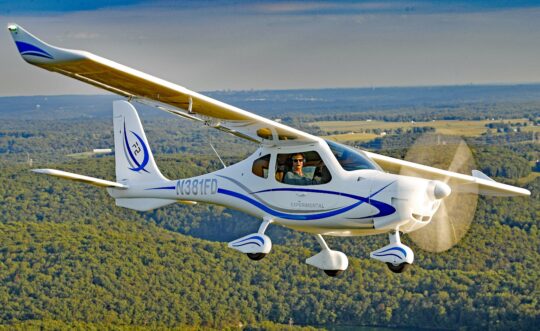 According to Mr. Betsch, the company is in a excellent condition and “healthy,” and the production increase in Czech Republic was anyway needed as the company is blessed by aircraft orders. The current order boost was mainly driven by the by the F-Series but the CT-series is still selling well. oth aircraft were showcased on their exhibit at AERO where the F2 H2 was highlighted and the personnel gave an update about their Ukrainian production facility during the event.
According to Mr. Betsch, the company is in a excellent condition and “healthy,” and the production increase in Czech Republic was anyway needed as the company is blessed by aircraft orders. The current order boost was mainly driven by the by the F-Series but the CT-series is still selling well. oth aircraft were showcased on their exhibit at AERO where the F2 H2 was highlighted and the personnel gave an update about their Ukrainian production facility during the event.
 After two years without the event, the JMB Aircraft crew has brought the VL3 Evolution to Aero Friedrichshafen and has — as usual — created big, better, perhaps the biggest stir ever. The booth was again in a prime location where JMB attracted most visitors on the AERO showcasing as a world premiere their, sleek, low wing composite rocket, which this time was powered by a French Turbotech TP-R90 130hp turboprop powerplant. See our
After two years without the event, the JMB Aircraft crew has brought the VL3 Evolution to Aero Friedrichshafen and has — as usual — created big, better, perhaps the biggest stir ever. The booth was again in a prime location where JMB attracted most visitors on the AERO showcasing as a world premiere their, sleek, low wing composite rocket, which this time was powered by a French Turbotech TP-R90 130hp turboprop powerplant. See our 

 This year the most advanced model Blackwing 635RG was on display, in a visible carbon finish with orange stripes called Nardo Grey, powered by the Rotax 915iS engine. The 635RG aircraft has completed the German UL-DULV certification process (similar to FAA’s SLSA) and the delivery will start in May.
This year the most advanced model Blackwing 635RG was on display, in a visible carbon finish with orange stripes called Nardo Grey, powered by the Rotax 915iS engine. The 635RG aircraft has completed the German UL-DULV certification process (similar to FAA’s SLSA) and the delivery will start in May.
 In this year the biggest surprise was the announcement by mid-March that Textron acquired Pipistrel. Textron Inc., home to the Cessna, Beechcraft, and Bell aviation brands, announced it has entered into an agreement to purchase Pipistrel based in Slovenia and Italy. The transaction is expected to close during the second quarter of 2022.
In this year the biggest surprise was the announcement by mid-March that Textron acquired Pipistrel. Textron Inc., home to the Cessna, Beechcraft, and Bell aviation brands, announced it has entered into an agreement to purchase Pipistrel based in Slovenia and Italy. The transaction is expected to close during the second quarter of 2022.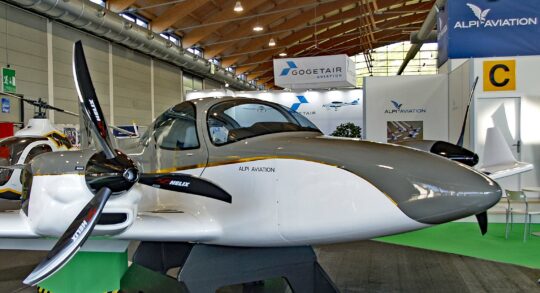
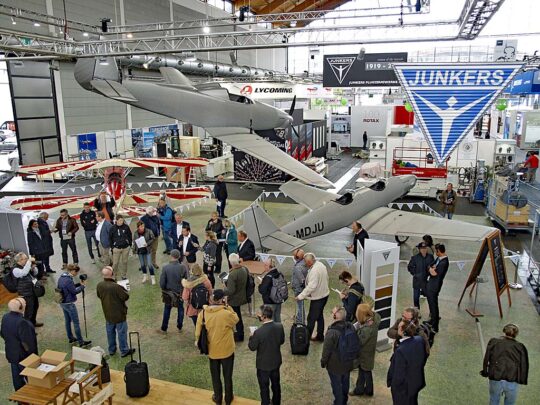
 Junkers also showcased the A50 — that was introduced in 2021 — and a similar version called A60. The A50, the corrugated aluminum, open two seater was for the first time presented in public. The new edition of the A50 Junior, whose historical counterpart first flew in 1929, is now powered by a 100hp (74 kW) Rotax 912iS with electronic fuel injection. The A50 has a modern version of the ancient fixed main gear. Garmin contributes the avionics. A complete rescue system, which is mandatory for ultralight aircraft, is also installed. When cruising, the open low-wing aircraft should reach around 190 km/h (103 knots) and consume 15 liters per hour (4 kph). The stall speed is less than 80 km/h (43 knots). The first 29 copies will be sold at the introductory price of €179.000
Junkers also showcased the A50 — that was introduced in 2021 — and a similar version called A60. The A50, the corrugated aluminum, open two seater was for the first time presented in public. The new edition of the A50 Junior, whose historical counterpart first flew in 1929, is now powered by a 100hp (74 kW) Rotax 912iS with electronic fuel injection. The A50 has a modern version of the ancient fixed main gear. Garmin contributes the avionics. A complete rescue system, which is mandatory for ultralight aircraft, is also installed. When cruising, the open low-wing aircraft should reach around 190 km/h (103 knots) and consume 15 liters per hour (4 kph). The stall speed is less than 80 km/h (43 knots). The first 29 copies will be sold at the introductory price of €179.000
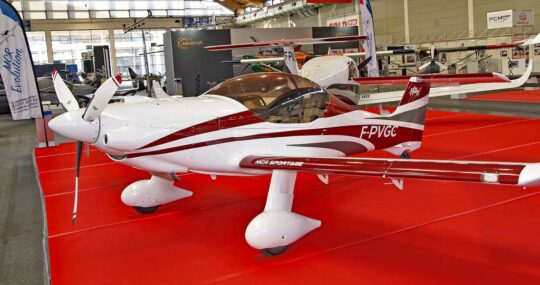
 The A414 is a relatively big, actually huge, bird and remembers to the Cirrus piston aircraft range.
The A414 is a relatively big, actually huge, bird and remembers to the Cirrus piston aircraft range.




 Heron has some military roots; founders have over 40 years of experience in the aviation and defense industry, as well as a long history of producing small (up to 300 kg of thrust) jet engines, according to Mr. Alex Fatseas of Heron.
Heron has some military roots; founders have over 40 years of experience in the aviation and defense industry, as well as a long history of producing small (up to 300 kg of thrust) jet engines, according to Mr. Alex Fatseas of Heron. The two independent, V2 twin engines, 4-stroke engines are supercharged by two electrically driven blowers and are are made using Rotax engines parts. The combustion units are combined with an electric motor and a battery. All drive units act on the propeller shaft and work either in combustion or electric or combined mode depending on the flight phase. They are controlled by a sophisticated FADEC system (Full Authority Digital Engine Control).
The two independent, V2 twin engines, 4-stroke engines are supercharged by two electrically driven blowers and are are made using Rotax engines parts. The combustion units are combined with an electric motor and a battery. All drive units act on the propeller shaft and work either in combustion or electric or combined mode depending on the flight phase. They are controlled by a sophisticated FADEC system (Full Authority Digital Engine Control). Rotax had a VR Technology Presentation — In cooperation with LLS Ltd., Rotax developed a VR-Technology software tool for maintenance, training and sales activities.
Rotax had a VR Technology Presentation — In cooperation with LLS Ltd., Rotax developed a VR-Technology software tool for maintenance, training and sales activities. The engine called UL520T is based on the 200 hp UL520 engine, which received an exhaust gas turbocharger. This turbo does not primarily have the function of significantly increasing engine performance, but serves as a turbo normalizer, which is intended to maintain performance with altitude. This engine, rated at 220 horsepower at sea level, is said to deliver all the power up to 15,000 feet, according to the manufacturer.
The engine called UL520T is based on the 200 hp UL520 engine, which received an exhaust gas turbocharger. This turbo does not primarily have the function of significantly increasing engine performance, but serves as a turbo normalizer, which is intended to maintain performance with altitude. This engine, rated at 220 horsepower at sea level, is said to deliver all the power up to 15,000 feet, according to the manufacturer. This year, the newly developed turbine is approaching serial production. First deliveries are scheduled for mid-2022. The first two installations in an UL were an unbelievable success (see JMB & Bristel/BRM contribution) which caused a big stir at Aero 2022.
This year, the newly developed turbine is approaching serial production. First deliveries are scheduled for mid-2022. The first two installations in an UL were an unbelievable success (see JMB & Bristel/BRM contribution) which caused a big stir at Aero 2022. Hirth has updated its two-stroke 35 Engine Series with new options and is offering this 70hp two-cylinder, liquid cooled power horse for manned and unmanned applications. The 3507HF version is successfully used in different UAVs and currently one system is in test-phase stage with the German Navy.
Hirth has updated its two-stroke 35 Engine Series with new options and is offering this 70hp two-cylinder, liquid cooled power horse for manned and unmanned applications. The 3507HF version is successfully used in different UAVs and currently one system is in test-phase stage with the German Navy.

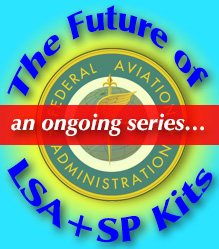 You know about drones. You may not know they are presently restricted to visual line of sight. However, a line-of-sight drone won’t get your Amazon package delivered a few miles from the distribution center to your house.
You know about drones. You may not know they are presently restricted to visual line of sight. However, a line-of-sight drone won’t get your Amazon package delivered a few miles from the distribution center to your house.







 I’ll get to Speed Cruiser, ‘er… Journey in a minute but first a bit about a new collaboration forming at the DeLand, Florida airport. You know the place, where the DeLand Showcase ran for five years. In case you missed the news, DeLand Showcase is no more. Director Jana Filip departed to join Sun ‘n Fun so the event she expertly ran will now give way to something new, from someone else. More on that later.
I’ll get to Speed Cruiser, ‘er… Journey in a minute but first a bit about a new collaboration forming at the DeLand, Florida airport. You know the place, where the DeLand Showcase ran for five years. In case you missed the news, DeLand Showcase is no more. Director Jana Filip departed to join Sun ‘n Fun so the event she expertly ran will now give way to something new, from someone else. More on that later.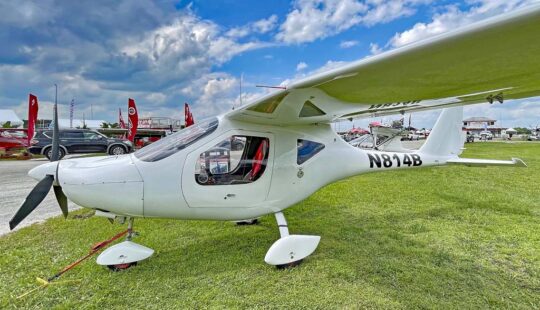
 When B.O.T. formed in Liechtenstein (a tiny but wealthy country near Switzerland) they had specific goals for their design:
When B.O.T. formed in Liechtenstein (a tiny but wealthy country near Switzerland) they had specific goals for their design: Flight Qualities
Flight Qualities



 Of course, most of the multicopter types — flying machines sometimes called eVTOLs — take off vertically but those are different, electric flying animals. Despite waves of breathless reporting by mainstream media types, eVTOLs are not yet ready for prime time. Even if you could buy one, you probably don’t want to pay for it. Most will be very expensive.
Of course, most of the multicopter types — flying machines sometimes called eVTOLs — take off vertically but those are different, electric flying animals. Despite waves of breathless reporting by mainstream media types, eVTOLs are not yet ready for prime time. Even if you could buy one, you probably don’t want to pay for it. Most will be very expensive. Developed by Miroslav Črv, Mirocopter is based in Slovenia — also the home of Pipistrel. With today’s news you might wonder, so let me assure the country is not near Ukraine and all that regrettable turmoil. Slovenia is immediately south of Austria and more than 400 miles to the west of the war zone.
Developed by Miroslav Črv, Mirocopter is based in Slovenia — also the home of Pipistrel. With today’s news you might wonder, so let me assure the country is not near Ukraine and all that regrettable turmoil. Slovenia is immediately south of Austria and more than 400 miles to the west of the war zone.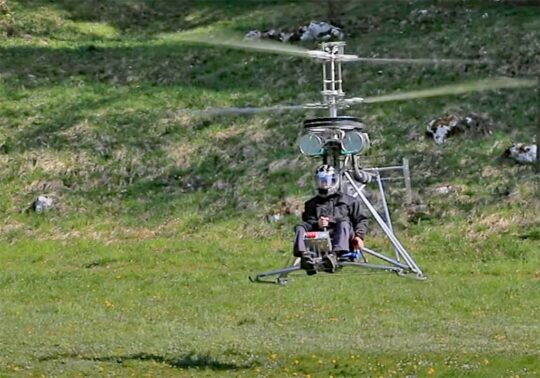 Vertical thrust is achieved by collective blade pitch control of both rotors. For directional control, cyclic blade pitch control of both rotors is used. Yaw control is provided by moving tail plates. For vertical thrust, direction, and yaw control, SCH-2A helicopter is equipped with standard helicopter control inputs.
Vertical thrust is achieved by collective blade pitch control of both rotors. For directional control, cyclic blade pitch control of both rotors is used. Yaw control is provided by moving tail plates. For vertical thrust, direction, and yaw control, SCH-2A helicopter is equipped with standard helicopter control inputs. Mark Rumsey and Andrey Vegger have each signed up to help Mirocopter get started in the USA.
Mark Rumsey and Andrey Vegger have each signed up to help Mirocopter get started in the USA. At present, neither man has flown Mirocopter. I asked Mark why he chose SCH-2A?
At present, neither man has flown Mirocopter. I asked Mark why he chose SCH-2A? “The first units will arrive in the U.S. in June so I haven’t flown it yet,” Mark said honestly. “I am an aerospace engineer and have taken the controls of a Jet Ranger and an R22 in steady forward flight but nothing beyond that. I have about 20 hours training in X-plane with my helicopter control simulator.”
“The first units will arrive in the U.S. in June so I haven’t flown it yet,” Mark said honestly. “I am an aerospace engineer and have taken the controls of a Jet Ranger and an R22 in steady forward flight but nothing beyond that. I have about 20 hours training in X-plane with my helicopter control simulator.” “Recommended training,” Mark continued, “is to become a proficient student in an R22 or equivalent two-seater. Eventually, we plan on offering training in a full-scale constraining simulator that allows you to hover and slowly move across the ground in all directions. It will be similar to
“Recommended training,” Mark continued, “is to become a proficient student in an R22 or equivalent two-seater. Eventually, we plan on offering training in a full-scale constraining simulator that allows you to hover and slowly move across the ground in all directions. It will be similar to  “Due to political reasons, I dropped my relationships with both of them. I am originally from Ukraine and both companies are Putin baked companies,” he opined. Then he found Mirocopter and Miroslav of Slovenia.
“Due to political reasons, I dropped my relationships with both of them. I am originally from Ukraine and both companies are Putin baked companies,” he opined. Then he found Mirocopter and Miroslav of Slovenia.
 This particular year, however, the company based in Mexico, Missouri celebrates its 30th anniversary. Beginning in 1992, Sebastien Heintz has paired popular designs with hard work to build his company to occupy the number one slot as seen in our
This particular year, however, the company based in Mexico, Missouri celebrates its 30th anniversary. Beginning in 1992, Sebastien Heintz has paired popular designs with hard work to build his company to occupy the number one slot as seen in our 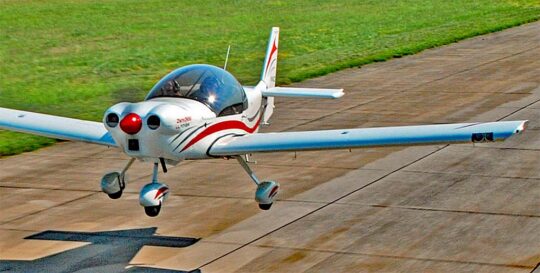 Zenith’s success benefits from decades of design work by Sebastien’s father, Chris Heintz. The latter passed away in 2021 but had been honored many times for his numerous accomplishments in creating enjoyable, affordable aircraft. His sons are all involved in the aviation business. Any entrepreneur will admit that is quite unusual.
Zenith’s success benefits from decades of design work by Sebastien’s father, Chris Heintz. The latter passed away in 2021 but had been honored many times for his numerous accomplishments in creating enjoyable, affordable aircraft. His sons are all involved in the aviation business. Any entrepreneur will admit that is quite unusual.

 Zenith’s top weekend is surely their well-attended
Zenith’s top weekend is surely their well-attended  Offer a Broad Line of Proven Models
Offer a Broad Line of Proven Models

 Some can pay the invoice on a high-end aircraft to enjoy its capabilities. That’s terrific. Who knows… you might score their used aircraft for a large discount in a few years. For many, though, new is nice yet something much more modest will suffice if it gets them safely up and down to enjoy the view of their surroundings or simply practice a few touch and goes. Any way you can fly is a good way, I’d say.
Some can pay the invoice on a high-end aircraft to enjoy its capabilities. That’s terrific. Who knows… you might score their used aircraft for a large discount in a few years. For many, though, new is nice yet something much more modest will suffice if it gets them safely up and down to enjoy the view of their surroundings or simply practice a few touch and goes. Any way you can fly is a good way, I’d say. “In 1998, we designed and built our first single place trike (the Maverick) featuring a strutted wing,” related Kamron. He was first to use struts on a delta wing, he reports. Yet even while Kamron created a growing number of trike models, he kept supplying the wings for other trike builders in the USA and other countries.
“In 1998, we designed and built our first single place trike (the Maverick) featuring a strutted wing,” related Kamron. He was first to use struts on a delta wing, he reports. Yet even while Kamron created a growing number of trike models, he kept supplying the wings for other trike builders in the USA and other countries.
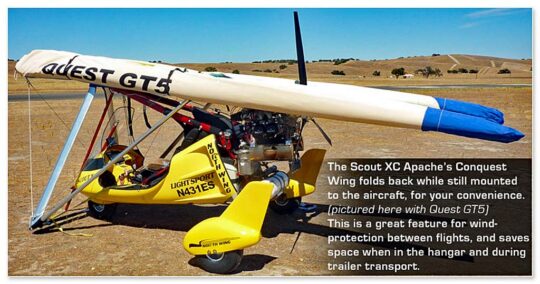 For many Americans, buying in the USA is important. “North Wing is an American company, and we maintain a large inventory so parts availability is only a few days away,” assured North Wing. That in-country service and availability will relieve you and can help keep your insurance cost lower.
For many Americans, buying in the USA is important. “North Wing is an American company, and we maintain a large inventory so parts availability is only a few days away,” assured North Wing. That in-country service and availability will relieve you and can help keep your insurance cost lower.
 Scout XC Apache
Scout XC Apache



 As recently as seven weeks before the show was to open (about as close to the show as I dared to wait to make airline and hotel reservations),
As recently as seven weeks before the show was to open (about as close to the show as I dared to wait to make airline and hotel reservations), 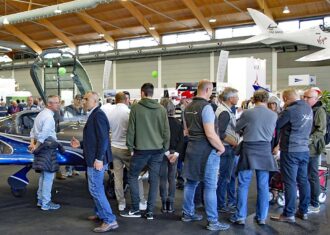






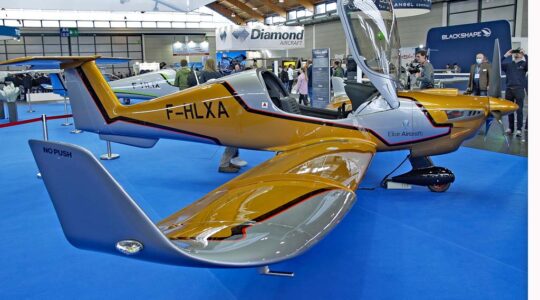


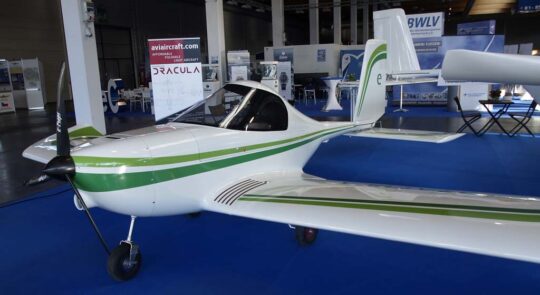





 True, most LSA are not recommended for aerobatic flying or training. However, one of the main reasons for that is that Rotax does not want their LSA 9-series engines used for aerobatics. If the engine manufacturer does not permit that, we’re done talking. It cannot be used that way. The airframe maker can also stipulate no such operations.
True, most LSA are not recommended for aerobatic flying or training. However, one of the main reasons for that is that Rotax does not want their LSA 9-series engines used for aerobatics. If the engine manufacturer does not permit that, we’re done talking. It cannot be used that way. The airframe maker can also stipulate no such operations. Instead, Magnus will use a ULPower engine. The latter has anticipated this use and the Belgian company recently declared that it meets all ASTM standards applicable to aircraft engines (specifically the F2339-19A standard for reciprocating spark engines for Light-Sport Aircraft).
Instead, Magnus will use a ULPower engine. The latter has anticipated this use and the Belgian company recently declared that it meets all ASTM standards applicable to aircraft engines (specifically the F2339-19A standard for reciprocating spark engines for Light-Sport Aircraft). “Magnus Aircraft is proud to announce its Fusion 212 airplane is approved for intentional spin. Starting now (April 2022), complete stall and spin awareness training, which is required for all CFIs as per FAR 61.183, can be [done] on the Fusion 212,” wrote László Boros, CEO of Magnus.
“Magnus Aircraft is proud to announce its Fusion 212 airplane is approved for intentional spin. Starting now (April 2022), complete stall and spin awareness training, which is required for all CFIs as per FAR 61.183, can be [done] on the Fusion 212,” wrote László Boros, CEO of Magnus. “UL Power confirmed their ASTM declaration stating that the 350 and 520 engines are ASTM-compliant and can be used on SLSA,” Doma added.
“UL Power confirmed their ASTM declaration stating that the 350 and 520 engines are ASTM-compliant and can be used on SLSA,” Doma added. “Magnus successfully completed the comprehensive intentional spin and recovery test series,” Doma elaborated, “so the Fusion 212 airplane is approved for upset recovery training (UPRT), intentional spin and basic aerobatics (+6/-3Gs), which is extremely important for flight safety. Fusion 212 is the first and only available Light Sport Aircraft for these maneuvers.” (Note that Tecnam acquired the single-seat
“Magnus successfully completed the comprehensive intentional spin and recovery test series,” Doma elaborated, “so the Fusion 212 airplane is approved for upset recovery training (UPRT), intentional spin and basic aerobatics (+6/-3Gs), which is extremely important for flight safety. Fusion 212 is the first and only available Light Sport Aircraft for these maneuvers.” (Note that Tecnam acquired the single-seat 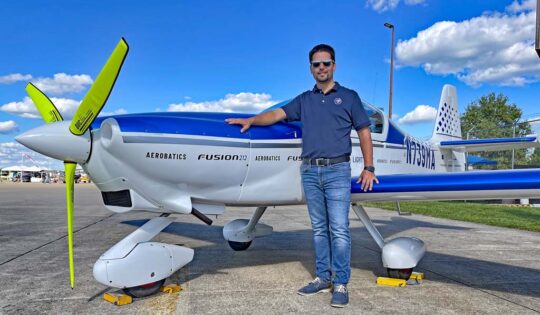 However, he fell in love with aviation while working for Magnus in Europe and later in the USA, first residing in Texas though he and his family have now relocated to Florida. Doma earned his pilot license in 2020 and is working towards his instructor ticket.
However, he fell in love with aviation while working for Magnus in Europe and later in the USA, first residing in Texas though he and his family have now relocated to Florida. Doma earned his pilot license in 2020 and is working towards his instructor ticket.